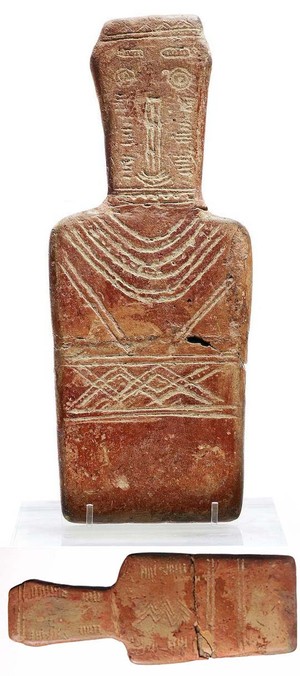Cypriot small Plank Figure: (Early Bronze Age III Middle BA I) : 2100-1800 BC
This is a very small (18.3cm) plank figure, though smaller freestanding ones are known (and even smaller ones attached to pots). It is very unusual in not having a protuberant nose. See my second and third plank figures for a general discussion of them.
Like most plank figures, this is Red polished Ware (pottery covered in a red slip) decorated with incised lines filled with lime. It does not have pierced ears or protuberant breasts or nose: the latter most unusual . However it has features that are common in other types and were not represented on my larger one. Most especially it has the incised lines normally interpreted as necklaces (not continued at the back). It also has the two diagonal lines below these which were at one time interpreted as arms (they sometimes end in a group of small puncture marks) but are now most often interpreted as large bronze or copper toggle pins holding the garment at the shoulders, such as have often been found in graves. There are also eyebrows and circular eyes plus vertical grooves ending in something that looks like a mouth, but it is not certain that this is a nose: it has sometimes been interpreted as a filtrum (the groove below the nose). Horizontal lines on the cheeks (found frequently on plank figures) could be tattoos or scarification simply painted facial decoration, but they are repeated on the back of the head and lower on the sides of the back (and the back of my larger example). Vertical zig-zag lines down the upper back would normally represent hair but strangely do not also appear on the back of the head. A criss-cross pattern, between the lower horizontal lines, presumably decoration on clothing) appear at the front but are left out at the back which is fairly plain. The vertical zig-zags marks at the top of the back (normally depicting hair) which normally continue all the way up the back of the head stop below the head, which is strange.
There are breaks at neck and waist which have been consolidated, but the Christies catalogue of 1989, and the Sotheby's catalogue 1993 do not show the waist breakage as it is now - with a small piece missing - and it must have been broken again at a later stage, losing large fragments at the back which were not restored when it was mended, leaving the old consolidation on display there and the strange appearance of another surface, possibly caused by folding of the clay when originally made. Alternatively, as Colin Bowles' restorer suggested, the apparently very old glue inside may have failed and fragments become detached. Many (anything from 20 - 50%) of these figures have been conjectured to have been "deliberately" broken across the middle of the torso before being placed in the tomb (probably to kill them to enter the world of the dead). They are almost always restored now. Perhaps there might still be some way to tell if this was the case with this one but the double breakage might make this problematical. Alternatively, a curator has pointed out that they are mostly not well fired and break accidentally quite easily (he admitted ruefully that this had happened to him). An upper corner of the head may be restored and there is much erosion of the slip at the back (possibly it may have been moved around while lying on its back in the tomb?) he vertical zig-zags marks at the top of the back (normally depicting hair) which normally continue up the back of the head stop below the head, which is strange.
I am not certain that the head and body are from the same figure. If not, investigation of the edges might show filing to make them fit. The head seems a very slightly paler than the body.The short horizontal lines on the back of the head are frequently found on the back of these figures and the fact that they match those on the back of the body could be a coincidence. I know of only one canonical early plank figure which lacks a protuberant nose as this one does (a rather similar one in V Karageorhis' encyclopaedic "The Coroplastic Art of Ancient Cyprus" Vol I, p.58 No 15, which also has this unusual head shape and I have to assume is genuine). This is another factor which worried me, though there is a slight scar where the nose should be which might indicate a nose which was added but failed to adhere properly. The design is otherwise almost identical to the most reproduced plank in the Cyprus Museum. However I may be worrying unnecessarily as the conservator at a major museum and and "experts" working for Bonhams think it is OK (the former judging only from photos).
Size: 18.3cm high
(Ex the James Chesterman collection. Chesterman (1926-2014) was a publisher. His main collection was given to the Fitzwilliam Museum in Cambridge in 1979, but he continued to collect, buying this piece from a Christies auction 12th Dec. 1989, lot 191. Later)
(Aquired Bonhams auction Nov. 30th 2016, lot 10)
DJ76

